There are television shows that changed the way my brain worked. The Prisoner. Twin Peaks. The Adventures of Pete & Pete.
One that wiggled into my brain early was The Twilight Zone, the original series that aired from 1959 to 1964. I would have seen it on tape and in syndication much later. In my teen years, they started running marathons on the Sci-Fi Channel. I would live in the Zone for days at a time, my life narrated by Rod Sterling.
It’s an anthology series, and each episode is a standalone story with different creators. Episodes are usually creepy, but many are heartwarming or nostalgic. The omniscient narrator, Rod Sterling, sets the stage with his trademark dry style, and he wraps it up at the end with a moral or one last attempt to give you the heebie-jeebies. Most trips through the Twilight Zone have a twist ending that sticks with you.
Sure, some episodes are duds, but The Twilight Zone has some of the best directing, acting, and writing in the history of TV. I recently watched through the entire series, and here’s what it taught me about storytelling.
It’s all about the lighting
The Twilight Zone has a distinctive look. Directors often utilize a technique called chiaroscuro lighting, which uses shadows to create shapes and tell the eye where to focus. The high contrast between light and dark looks amazing in black and white. But more importantly, it sets the tone.

Bonus dutch angle! “The Howling Man,” 1960
Lighting wasn’t the only tool in their tool box. They throw in tilted dutch angles, claustrophobic close-ups, and blaring musical cues. And all of it is used to set the tone of the scene. You might be in the dark about what’s really going on in the story, but there’s never any doubt about how you’re meant to feel.
I’m a writer, so I have my own set of tricks to move the spotlight and control the tone of a scene. Metaphor, word choice, sentence and paragraph length–there are countless ways to encourage the reader to experience the intended emotions.
Whatever your storytelling medium, don’t skimp on the lighting.
Don’t waste the budget on rubber monsters
I was flipping through channels once with my dad, and we settled on something with a flying saucer and a big rubber alien. My dad wondered if it was The Outer Limits or The Twilight Zone. I’d never seen that one before, but I said it had to be The Outer Limits. When it turned out I was right, my dad, understandably impressed at my useless talent, asked how I knew. I said, “The Twilight Zone doesn’t have rubber monsters.”
Rod Sterling had plenty of fights with the network about budget. They hired talented actors, built lavish sets, and bought great scripts. But they didn’t waste money on monsters. Rubber aliens showed up on occasion, but almost always for comedic effect. Because rubber monsters look silly.

Fortunately, we don’t see too much of this. “Mr. Dingle, The Strong,” 1961.
H.P. Lovecraft, the most ripped-off horror writer of the 20th century, said, “The oldest and strongest emotion of mankind is fear. And the oldest and strongest kind of fear is fear of the unknown.” His stuff was so scary because he didn’t over-describe his beasties. He told the reader just enough so the reader could scare themselves.
One of the best examples of rubber monsters done right is Ridley Scott’s Alien. That alien is terrifying because they keep it in the shadows. There’s a deleted scene where alien is brightly lit and onscreen for way too long. Suddenly it isn’t a nightmarish killing machine. It’s a guy in a rubber suit crabwalking around.
So let the audience fill in the blanks. This doesn’t just apply to creepy crawlies or murders, either. I think the reader can think of a steamier <ahem> romantic interlude than I can write. So I set the stage and let their imagination run wild. A peek is better than an anatomy lesson. I wouldn’t do this if I were writing bodice rippers, of course, unless I wanted to give out refunds.
Wrap it all up in 22 minutes
There are five seasons of The Twilight Zone. Seasons 1,2,3, and 5 have half-hour episodes, so they’re 22 minutes without commercials. Season 4 had a one-hour time slot, so episodes were over twice as long at about 50 minutes.
One of the reasons the show is still popular is the usual short length. Rod Sterling and the other writers were able to develop an entire world of original characters between commercial breaks. This forced them to trim the fat and make every second count.
Season 4 was different. The doubled length meant padding and needless repetition. Worst of all, it gave the audience time to catch up. I can’t imagine someone getting to the end of these episodes without knowing the twist. “Oh, he was dead all along? I called that ten minutes in!”

It could have been a classic episode, but no one wants to sit through it. “Printer’s Devil,” 1963.
It’s tempting to make a story longer than it needs to be. I’m the worst about this, and I’m lucky to have a critique group to reign me in.
Cut out scenes that don’t set the tone, move the plot along, or develop characters. Combine characters when possible. Delete superfluous words. It’s hard, but sometimes you should just let a novella be a novella.
Hopefully you can benefit from my binge watching and overthinking about a fifty-year-old TV show. The whole series is available on Hulu, and everything except season 4 is on Netflix. Just stay on your guard, because not everyone makes it out of… The Twilight Zone.
Buh buh buh buuuuuh!





